
The Mongol Empire invaded and conquered much of Kievan Rus' in the mid-13th century, sacking numerous cities including the largest such as Kiev and Chernigov. The Mongol siege and sack of Kiev in 1240 is generally held to mark the end of Kievan Rus' as a distinct, singular polity. Many other Rus' principalities and urban centres in the northwest and southwest escaped destruction or suffered little to no damage from the Mongol invasion, including Galicia-Volhynia, Novgorod, Pskov, Smolensk, Polotsk, Vitebsk, and probably Rostov and Uglich.

The Tatars, formerly also spelt Tartars, is an umbrella term for different Turkic ethnic groups bearing the name "Tatar" across Eastern Europe and Asia. Initially, the ethnonym Tatar possibly referred to the Tatar confederation. That confederation was eventually incorporated into the Mongol Empire when Genghis Khan unified the various steppe tribes. Historically, the term Tatars was applied to anyone originating from the vast Northern and Central Asian landmass then known as Tartary, a term which was also conflated with the Mongol Empire itself. More recently, however, the term has come to refer more narrowly to related ethnic groups who refer to themselves as Tatars or who speak languages that are commonly referred to as Tatar.

The Golden Horde, self-designated as Ulug Ulus, was originally a Mongol and later Turkicized khanate established in the 13th century and originating as the northwestern sector of the Mongol Empire. With the division of the Mongol Empire after 1259, it became a functionally separate khanate. It is also known as the Kipchak Khanate or as the Ulus of Jochi, and it replaced the earlier, less organized Cuman–Kipchak confederation.
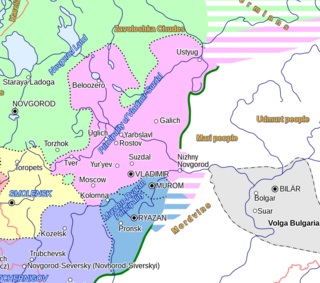
Vladimir-Suzdal, formally known as the Principality of Vladimir-Suzdal or Grand Principality of Vladimir (1157–1331), also as Suzdalia or Vladimir-Suzdalian Rus', was one of the major principalities emerging from Kievan Rus' in the late 12th century, centered in Vladimir-on-Klyazma. With time the principality grew into a grand principality divided into several smaller principalities. After being conquered by the Mongol Empire, the principality became a self-governed state headed by its own nobility. A governorship of the principality, however, was prescribed by a jarlig issued from the Golden Horde to a Rurikid sovereign.

Volga Bulgaria or Volga–Kama Bulgaria was a historical Bulgar state that existed between the 9th and 13th centuries around the confluence of the Volga and Kama River, in what is now European Russia. Volga Bulgaria was a multi-ethnic state with large numbers of Bulgars, Finno-Ugrians, Varangians and East Slavs. Its strategic position allowed it to create a local trade monopoly with Norse, Cumans, and Pannonian Avars.

The Khanate of Kazan was a medieval Tatar Turkic state that occupied the territory of the former Volga Bulgaria between 1438 and 1552. The khanate covered contemporary Tatarstan, Mari El, Chuvashia, Mordovia, and parts of Udmurtia and Bashkortostan; its capital was the city of Kazan. It was one of the successor states of the Golden Horde, and it came to an end when it was conquered by the Tsardom of Russia.
Bilär - was a medieval city in Volga Bulgaria and its second capital before the Mongol invasion of Volga Bulgaria. It was located on the left bank of the Small Cheremshan River in Alexeeyevsky District of the Tatarstan. The distance to Bilyarsk is 50 km and 150 km to Kazan.

Aq Bars is the emblem of Tatarstan. It is an ancient Bulgar symbol translated as "White Leopard" or "Snow Leopard", and has been in use since 1991 as the official symbol of Tatarstan.
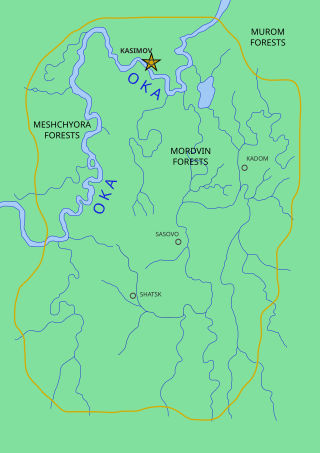
Qasim Khanate or Kingdom of Qasim or Khanate of Qasım was a Tatar-ruled khanate, a vassal of Russia, which existed from 1452 until 1681 in the territory of modern Ryazan Oblast in Russia with its capital at Kasimov, in the middle course of the Oka River. It was established in the lands which Grand Prince Vasily II of Moscow presented in 1452 to the Kazan prince Qasim Khan, son of the first Kazan khan Olug Moxammat.
The Mongol invasion of Volga Bulgaria lasted from 1223 to 1236. The Bulgar state, centered in lower Volga and Kama, was the center of the fur trade in Eurasia throughout most of its history. Before the Mongol conquest, Russians of Novgorod and Vladimir repeatedly looted and attacked the area, thereby weakening the Bulgar state's economy and military power. The latter ambushed the Mongols in the later 1223 or in 1224. Several clashes occurred between 1229–1234, and the Mongol Empire conquered the Bulgars in 1236.

The territory of Tatarstan, a republic of the Russian Federation, was inhabited by different groups during the prehistoric period. The state of Volga Bulgaria grew during the Middle Ages and for a time was subject to the Khazars. The Volga Bulgars became Muslim and incorporated various Turkic peoples to form the modern Volga Tatar ethnic group.
Zilant is a legendary creature, something between a dragon and a wyvern. Since 1730, it has been the official symbol of Kazan. This winged snake is mentioned in legends about the foundation of Kazan.

The Volga Tatars or simply Tatars are a Kipchak-Bulgar Turkic ethnic group native to the Volga-Ural region of Eastern European Russia. They are subdivided into various subgroups. Volga Tatars are the second-largest ethnic group in Russia after ethnic Russians. Most of them live in the republics of Tatarstan and Bashkortostan. Their native language is Tatar, a language of the Turkic language family. The predominant religion is Sunni Islam, followed by Orthodox Christianity.
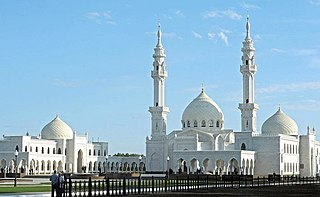
Bolgar is a town and the administrative center of Spassky District in the Republic of Tatarstan, Russia, located on the left bank of the Volga River, 140 kilometers (87 mi) from Kazan. As of the 2010 Census, its population was 8,650.
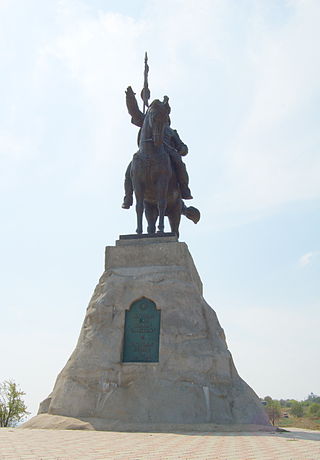
Bulgarism is an ideology aimed at the "revival of Bulgars' national identity" and Volga Bulgaria statehood. It originated in the second half of 19th century within the Wäisi movement and the Society for the study of the native land (Chuvashia) It was revived at the end of the 20th century as "neobulgarism" in Tatarstan, Bashkortoston and Chuvashia.
The siege of Bilär was a battle for the capital city of the Volga Bulgaria between the Volga Bulgars and the Mongols. It took place in autumn 1236 and lasted for 45 days. It ended with the total destruction of Bilär and the massacre of its population, estimated several dozen thousands.

Qul Ghali was a famous Muslim Volga Bulgarian poet. His most famous poem is Qissa-i Yusuf, written in the Old Tatar language, which is not mutually intelligible with the modern Tatar, Bashkir and Chuvash languages.

Spassky District is a territorial administrative unit and municipal district of the Republic of Tatarstan within the Russian Federation. The total area of the district is 2028 km². It is located in the southwestern part of Tatarstan. The administrative center is Bolgar. As of 2020, the population estimated at 18,599 residents.
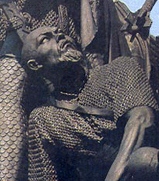
The Great Troubles, also known as the Golden Horde Dynastic War, was a war of succession in the Golden Horde from 1359 to 1381.




























